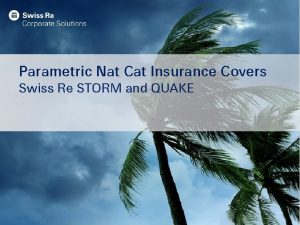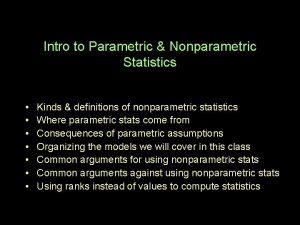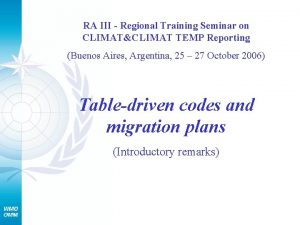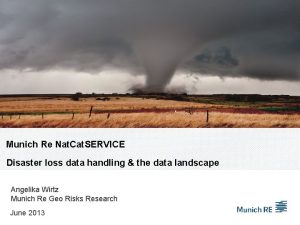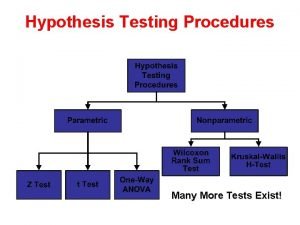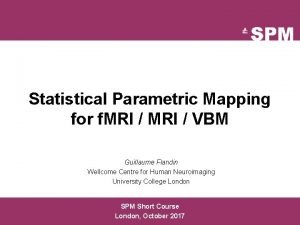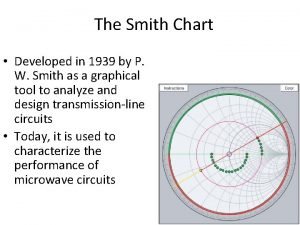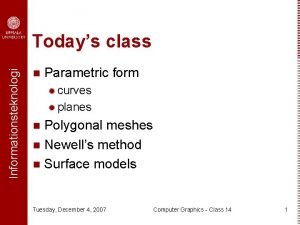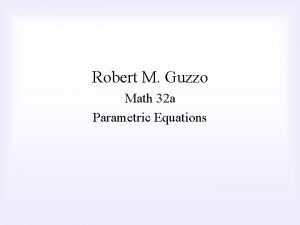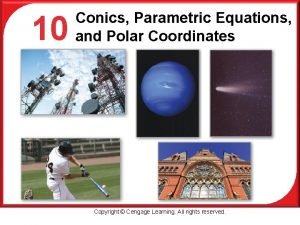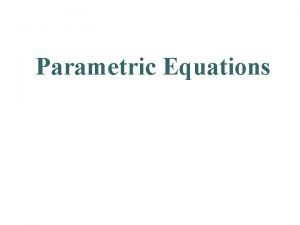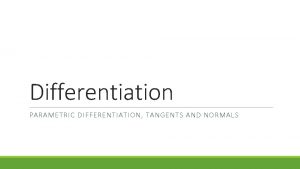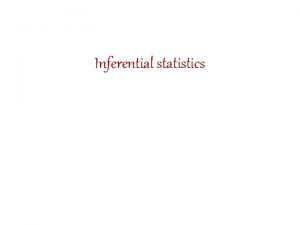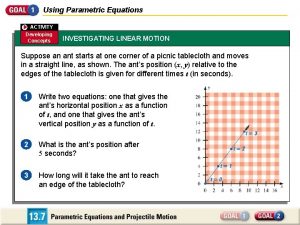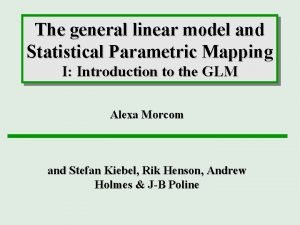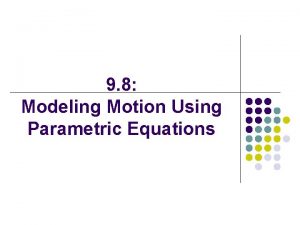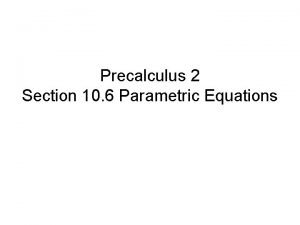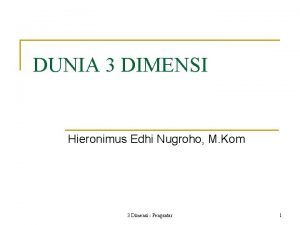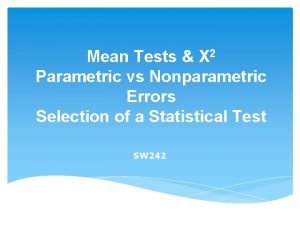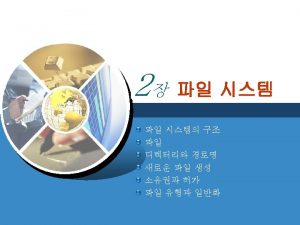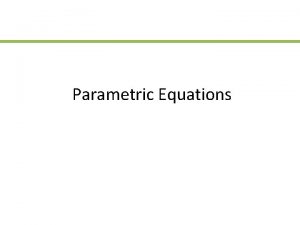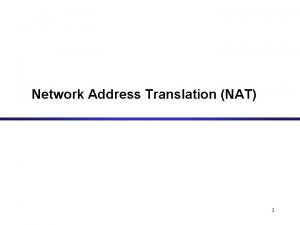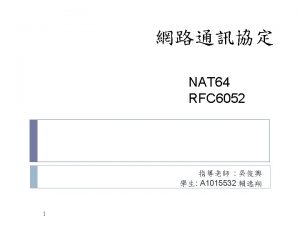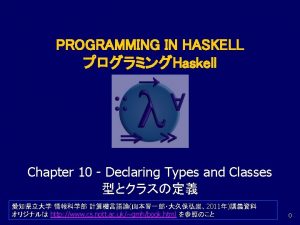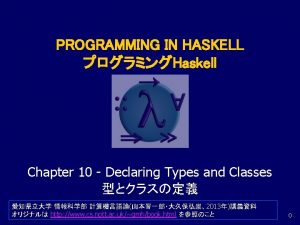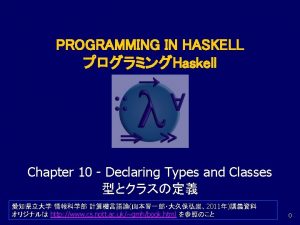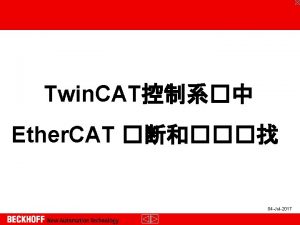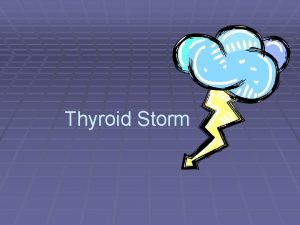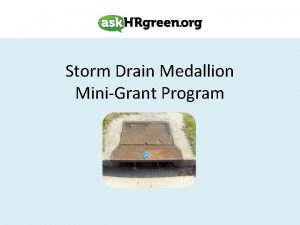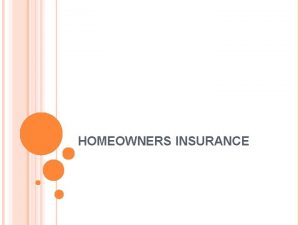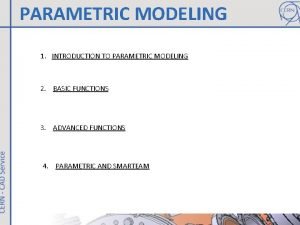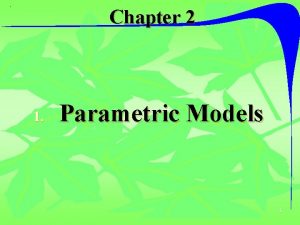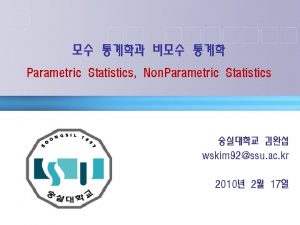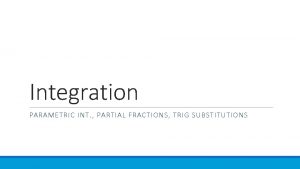Parametric Nat Cat Insurance Covers Swiss Re STORM




























- Slides: 28

Parametric Nat Cat Insurance Covers Swiss Re STORM and QUAKE 1

Parametric Nat Cat Insurance Background 2

Parametric Insurance Market – Background Information Key Industries / Occupancies • • • Hospitality : Hotel chains and single shot properties Private Equity : Hedge funds, nat cat exposed acquisitions Public Entity : States, counties, school districts, university systems Energy / Power : Offshore assets, T&D exposure Real Estate : Exposed office and retail schedules Many others… Client Motivation • • Supplement traditional insurance : In-fill deductible, top up limit, etc. Broad cover: any loss or expense resulting from the event Quick payout : Receive a payout in as little as 30 days post event Cover under- or uninsured risk : Wide area damage, non-physical damage BI, excluded classes of businesses in traditional market Swiss Re IRS Parametric Success • • Bound ~60 parametric deals in 2018 Predominantly Hurricane and Earthquake (although we consider many other perils) Annual premiums ranging from $3. 4 m (large) to $100 k (small) Wide variety of occupancy classes, but saw major success from private equity/hedge funds , hospitality , and public entity. 3

Needs for Parametric Nat Cat Insurance Covers • Buyer needs: § Protect against indirect economic loss § Quick payout, improves liquidity § Supplement traditional insurance § Simple and transparent claims process § Cover underinsured or uninsurable risk § Assist with post-event costs § In fill the large % deductible indirect loss emergenc y costs quick payout simple claims 4

What is a Parametric Nat Cat Insurance Cover? • Pre-defined event triggers and a table of payout factors are established. • A final policy is agreed to containing the details of the transaction and the requirements of the two parties (including trigger and payouts). • If an event occurs that meets or exceeds the pre-defined event trigger, then the product pays according to the payout table. • At a subsequent point in time (generally within 12 months of the event), the insured certifies that actual covered losses and expenses are greater than or equal to payout received. Define Triggers Bind Policy Event Occurs Payment Made Losses Confirmed *Note: This slide is a simple explanation of the product, the full policy will have all stipulations and details of the contract. 5

Why Parametric Nat Cat Insurance Cover? Indemnity Based Insurance Event Occurs Insured assesses damage Insured submits claim Insurer reviews claim Adjuster assesses and validates claim Claim is paid based on assessment Time Confirm proof of loss within a year Time Parametric Insurance Event Occurs Intensity verified by third-party Pay-out issued within 30 -days 6

Key Features of a Parametric Insurance Cover § Uses Independent Data Provider: Wind speeds from named windstorm provided by independent 3 rd party (RMS HWind) and the U. S. Geological Service (“USGS”). § Settlement: Based on RMS HWind reported wind speeds, or USGS shake intensities at your locations. § Offers Quick pay out: Pay out in as little as 30 days after notification of eligible event. § Coverage in Insurance Form: Insured has 12 months post event to determine and confirm actual financial loss. § Broad Coverage : All direct and indirect physical damage, loss of income, extra expense and any other expenses related to the Nat Cat event. § Addresses impact at a local level: The structure reflects the impact of and damage caused by wind speeds or shake intensities at each of your insured locations. § Deductible: None. 7

Swiss Re STORM 8

Swiss Re STORM Parametric Wind Intensity Specific to YOUR Exposure Limit Allocation • Limits are allocated to specific Trigger Locations (e. g. lat longs) to best reflect your exposure. Payout Table • Payout Table is established to determine the payout by wind speed at each Trigger Location. Event Reporting • Post-event we receive a wind footprint from RMS HWind, which is used to determine the wind speed at each Trigger Location. Payout • We pay you according to the HWind calculated wind speed and Payout Table. Loss Confirmation • You confirm to us that your loss from the event met or exceeded the payout. Hurricane Michael Footprint over Florida Source: RMS HWind 9

What is RMS HWind? NCE WO RLD E SCI S S CLA ENT M N Y VER OLOG O G HN TEC The sophisticated HWind Technology has been developed at the Hurricane Research Division of the National Oceanic & Atmospheric Administration (NOAA). T DUC RO P EN V PRO The HWind Technology has been developed by worldleading extreme wind researchers. It uses the best available data from aircraft reconnaissance (“Hurricane Hunters”), dropsondes, buoys, weather stations and satellites. The HWind Technology is robust and provides highly reliable data for every location on the map. Weather stations can fail – HWind never does. It has proven to work in dozens of Hurricanes over the past decade. *For more information, visit RMS HWind website: http: //www. rms. com/models/hwind 10

Sample Solution – South Florida Insured • Cover: Named Windstorm Insurance Policy • Term: Three years • Effective Date: TBD • Swiss Re Share : 100% • Trigger: One-minute sustained wind speed at each trigger location as reported by RMS HWind • Trigger Locations : Lat long center of each zip code where exposure is reported • Limit Allocation : Proportionally by TIV reported at each zip code • Payout Tables : See subsequent slide *Note: The above is a non-binding summary of our proposed structure. 11

Limit Allocation – Visual Trigger Location Map 12

Sample Solution – South Florida Insured Limit Option 1 Option 2 $25 m per occ / $50 m term aggregate $1, 165, 000 $955, 000 4. 7% 3. 8% Payout Table Estimated Premium* Rate-On-Line *Premiums are annual and exclude all brokerage, taxes and fees. 13

Limit Allocation Option 1 Option 2 14

Historical Payout – Hurricane Wilma – Option 1 Total Payout = $2, 500, 000 15

Swiss Re QUAKE Confidential 16

Swiss Re QUAKE Parametric Earthquake Shake Intensity Specific to YOUR Exposure Limit Allocation Payout Table • Limits are allocated to specific Trigger Locations (e. g. lat longs) to best reflect your exposure. • Payout Table is established to determine the payout by shake intensity (PSA 0. 3 s) at each Trigger Location. Event Reporting • Post-event we pull the USGS Shake. Map, which is used to determine the shake intensity (PSA 0. 3 s) at each Trigger Location. Payout • We pay you according to the USGS calculated shake intensity and Payout Table. Loss Confirmation USGS Shake. Map for Loma Prieta EQ (1989) • You confirm to us that your loss from the event met or exceeded the payout. Confidential 17

Earthquake: Intensity vs. Magnitude Trigger • Magnitude: The Magnitude is a quantitative measure of the size of the earthquake at its source. The Moment Magnitude Scale measures the amount of seismic energy released by an earthquake, as measured with a seismometer. Depending on the depth of the earthquake and the local soil types, same magnitude earthquakes can have a very different impact locally • Intensity : The effect of an earthquake on the Earth's surface is called the intensity. One intensity measure is the Spectral Acceleration (expressed in % of Earth’s acceleration g). This is the type of intensity measure Swiss Re’s QUAKE product uses. A certain Magnitude of an earthquake unfolds into different Intensities in affected areas. Swiss Re QUAKE product uses Intensity triggers in order to more closely reflect your direct and indirect financial loss. Confidential 18

2014 Napa Earthquake Magnitude 6. 0 Epicenter Downtown Napa PSA=80. 67 *USGS Peak Spectral Acceleration expressed as a percentage of gravity (%g) with a period of 0. 3 s ("PSA 03") Confidential 19

USGS San Andreas SCENARIO Event Magnitude 7. 7 Epicenter 70 s! ile M Silicon Valley PSA=96 *USGS Peak Spectral Acceleration expressed as a percentage of gravity (%g) with a period of 0. 3 s ("PSA 03") Confidential 20

Shaking Intensity – PSA 03 Explained Sample Experienced Shaking Severe: Damage slight in specially designed structure; considerable damage in ordinary substantial buildings with partial collapse. Damage great in poorly build structures; Fall of chimneys, factory stacks, columns, monuments, walls. Heavy furniture overturned. PSA 03 Range 115%g 90%g 75%g Very Strong: Damage negligible in buildings of good design and construction; slight to moderate in well-built ordinary structures; considerable damage in poorly built or badly designed structures; some chimneys broken. 60%g 45%g Strong: Felt by all, many frightened. Some heavy furniture moved; a few instances of fallen plaster. Damage slight. 30%g Physical descriptions of damage are from USGS and describe average impacts; actual observed conditions individual structures could diverge from average impact. Confidential 21

Swiss Re Sample Structures –Southern CA Insured • Cover: Parametric Earthquake Policy • Term: Three Years • Effective Date: TBD • Limit: $10, 000 per occurrence and in the aggregate for the term • Swiss Re Share : 100% • Trigger: Shake Intensity (PSA 0. 3) as reported by USGS at the Trigger Location • Trigger Location: Lat Long point associated with the client’s site *This proposed structure is not bindable and would be subject to further review and approval. Confidential 22

Swiss Re Sample Structures – Options Option 1 Option 2 $420, 000 $200, 000 4. 2% 2. 0% Payout Table Estimated Premium* Rate-On-Line *All premium figures are annual , exclusive of brokerage, taxes and fees. Confidential 23

Example Payout – What Has Happened (Recently)? M 6. 7 Northridge EQ – January 17, 1994 PSA 0. 3 @ Trigger Location: 31. 5% Epicenter Trigger Location Payout – Option 1 Payout – Option 2 More Info: https: //earthquake. usgs. gov/earthquakes/eventpage/ci 3144585/executive Confidential 24

Example Payout – What Could Happen? M 6. 4 SCENARIO Earthquake - Anaheim Epicenter Trigger Location PSA 0. 3 @ Trigger Location: 108. 1% Payout – Option 1 Payout – Option 2 More Info: https: //earthquake. usgs. gov/scenarios/eventpage/bssc 2014 anaheimellbgeol_m 6 p 39_se#shakemap Confidential 25

Appendix 26

Traditional Indemnity vs. Parametric Insurance Cover Traditional Insurance Parametric Covers Trigger Loss or damage to physical asset Event occurrence exceeding pre-agreed threshold or trigger Recovery Reimbursement of actual loss sustained following assessment Pre-agreed payment structure based on event intensity Basis Risk* Policy conditions, deductibles and exclusions Correlation of chosen triggers and structure with actual exposure Loss Assessment and Payment Months to several years depending on complexity of loss Very transparent and settlement within 30 days Term Usually annual Single or multi-year (1 -3 years; premium payable annually) Structure Standard products and contract wordings Customized product with high structuring flexibility (single trigger, multi-trigger) Form Insurance or Derivative Limit Market Up to $100 m. Higher may require a Cat Bond issuance Deductible 2% to 5% of insured value No $ deductible *Risk that Client’s collected payout is not equal to its actual loss. 27

Legal notice © 2018 Swiss Re. All rights reserved. You are not permitted to create any modifications or derivative works of this presentation or to use it for commercial or other public purposes without the prior written permission of Swiss Re. The information and opinions contained in the presentation are provided as at the date of the presentation and are subject to change without notice. Although the information used was taken from reliable sources, Swiss Re does not accept any responsibility for the accuracy or comprehensiveness of the details given. All liability for the accuracy and completeness thereof or for any damage or loss resulting from the use of the information contained in this presentation is expressly excluded. Under no circumstances shall Swiss Re or its Group companies be liable for any financial or consequential loss relating to this presentation. 28
 Parametric insurance nat cat
Parametric insurance nat cat Nonparametric tests
Nonparametric tests Boris epshtein
Boris epshtein Parametric
Parametric Bmk+
Bmk+ Cat 1 2 3 minima
Cat 1 2 3 minima Cat 1 cat 2 cat 3 aviation
Cat 1 cat 2 cat 3 aviation Munich re natcatservice
Munich re natcatservice Nature of fire insurance
Nature of fire insurance I bought me a cat and the cat pleased me
I bought me a cat and the cat pleased me Nonparametric test
Nonparametric test Spm jiscmail
Spm jiscmail Complete smith chart
Complete smith chart Equation of ellipse in parametric form
Equation of ellipse in parametric form Tinkercad parametric
Tinkercad parametric Parametric equations word problems
Parametric equations word problems Chapter 7 conic sections and parametric equations
Chapter 7 conic sections and parametric equations Cycloid parametric equation
Cycloid parametric equation Cartesian equation
Cartesian equation Parametric differentiation
Parametric differentiation Parametric and nonparametric statistics
Parametric and nonparametric statistics In a pumpkin tossing contest in morton illinois
In a pumpkin tossing contest in morton illinois Spm design matrix
Spm design matrix Vertical velocity
Vertical velocity Parametric equations precalculus
Parametric equations precalculus Parametric estimating
Parametric estimating Matplotlib parametric plot
Matplotlib parametric plot Mesh dengan surface segi-empat disimpansebagai
Mesh dengan surface segi-empat disimpansebagai Parametric vs nonparametric test
Parametric vs nonparametric test
